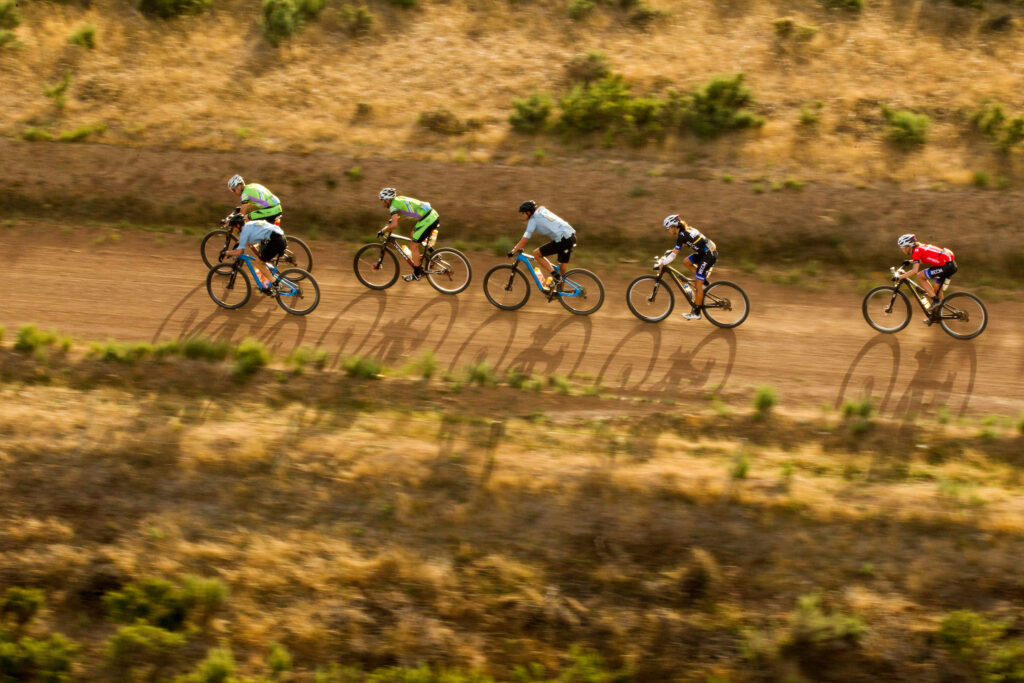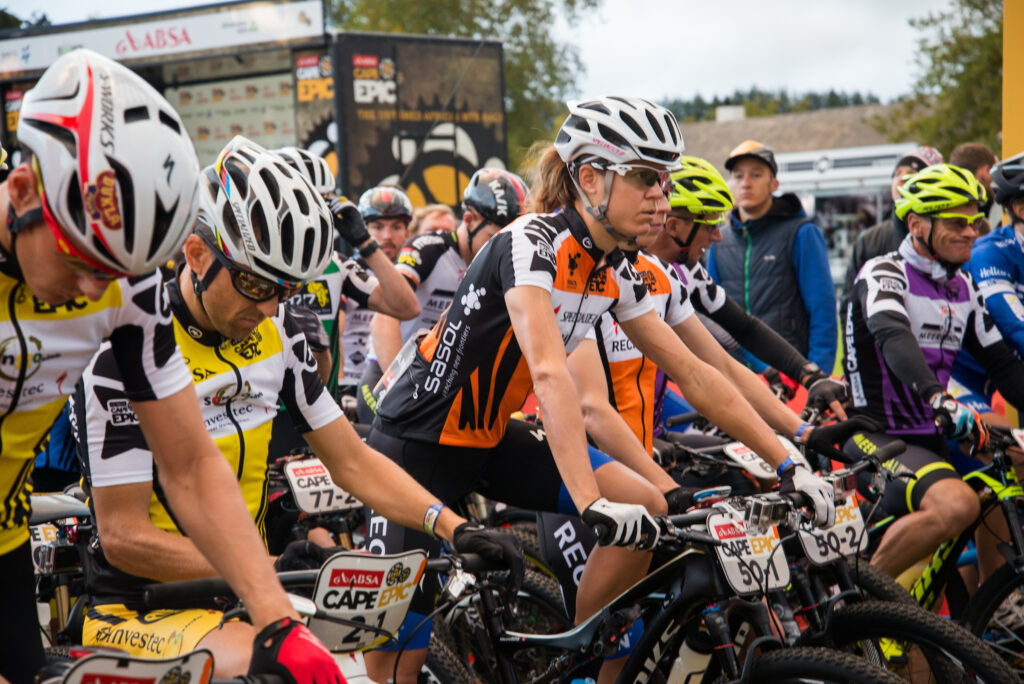In Marathon MTB races professionals and amateurs traditionally mix in the race and more often than not depart all together in a mass start, regardless of gender. Women came to accept that this male dominated discipline had no separate start line for them and that their race was interfered by the men.
As the women’s sport evolved over the years the female competitors are fighting for every second to outdo each other for the win, even on a 6 hour marathon across mountainous terrain. Any (unintentional) interference by the men through giving a draft or blocking in a trail may have a significant impact on the final results. This can’t be fair, right?
The TCA Ambition is to propose separate gender race starts for all UCI Marathon MTB races as well as all national, continental and world marathon championships from 2021 onwards with the creation of a new rule in the UCI MTB regulations. At the same time we demand a UCI rule to disqualify riders who draft riders from other categories, to ensure no interference during the course of the race when riders mix with other categories after the start.
Why do we want this? This will create a fair racing environment for all competitors to avoid undue influence from another category.
The Cyclists’ Alliance recognise that there are challenges to achieving this, so we’ve interviewed Ariane Lüthi, a Pro MTB racer and 5x Cape Epic Winner and 4x Swiss XCM Champion, as well as a Kati Csak from Absa Cape Epic and Bart Brentjens, team manager at CST PostNL Bafang to gather some different perspectives to help us move forwards to achieve separate starts for the Pro women.
Ariane, you are a MTB marathon specialist and fought for equal prize money in the past. Why do you feel it is important that event organisers provide a separate start for the women at marathon races?
A separate start is literally just the start. My wish is to achieve fair racing conditions for everyone and my goal is to accomplish not only a separate start for the women but a race where there is no interference between the different categories.
“In 2014, the Absa Cape Epic introduced a separate start for the women and equal prize money. As a result, we’ve seen an increasingly competitive field each year”
[Kati Csak, Senior Director Global Mountain Biking, Absa Cape Epic]
And why can’t a race be fair if men and women have a mass start as it is the case in many marathon races?
When women start together with the men, they can slip stream behind them but they can also be blocked by them. Whether one gets the benefit of a draft or the disadvantage of being held back in a trail because a man is in front of a woman, depends very much on luck. That’s not fair.
When motorbikes gave a draft to the riders in the World Tour road races because they were getting too close to the riders, there was a huge outcry and the UCI changed rules to avoid that, also for safety reasons. It’s strange to me, that the UCI doesn’t recognise how unfair the situation is in marathon MTB racing.
What do you wish the UCI would change?
Racing in South Africa I always thought that there is a UCI rule that would forbid slip streaming behind men, if the women have a separate start. At the UCI races and even most other races I did down south that was always the case. The commissaire made it clear at the managers meeting and on the start line that we would be disqualified if we’d draft behind a man’s wheel.
At the Marathon European Championship in Italy in 2018 I found out there is not actually a UCI rule forbidding the drafting. Originally the Italian organisers planned a mass start with all the men and women. I couldn’t believe that even a Continental Championship wouldn’t have a separate start, so I wrote them an email suggesting otherwise. Eventually I succeeded and we started separate, although only 2 minutes after the Elite men. The women’s bunch soon caught some of the slower men and it was obvious that some women were using the draft behind men to their advantage. When I asked the UCI commissaire about it at the finish, he told me that there was no such rule. He also told me that it was “only" a European Championship, so it wouldn’t matter that much. The last words definitely added fuel to my quest to change this and push the UCI to create such a rule.
Apart from a rule that forbids drafting between categories if the women start separate from the men, I find that at least the national, continental and world championships must have a separate start. A separate start also gives more recognition to the women.
But it would be impossible to control whether women are drafting or not, no?
Indeed, it wouldn’t be possible to police the rule all the way. However, is it possible to control whether someone threw a paper away? It’s not, but in many races littering would lead to a disqualification or time penalty. The Cape Epic and many other races don’t allow drafting between the categories since they introduced a separate start and it works extremely well. I haven’t heard of a women’s team cheating. The rule must just be communicated very well. At the Cape Epic and Tankwa Trek race for example they now also started to communicate better that men aren’t allowed to draft the women. If a women’s team first has to overtake a whole bunch of men, before they can get onto the competition’s wheel ahead of them it is also not fair. It is important to make the men understand that they should keep themselves out of the women’s race as much as possible.

“Drafting should be forbidden, as I believe this has the biggest advantage for riders, but it’s easy to check and penalize”
[Bart Brentjens, team manager CST PostNL Bafang MTB Racing Team]
Isn’t it extremely difficult to organise that there won’t be any interference between categories?
It definitely is a challenge. And no interference at all is the ideal scenario that in reality won’t be achieved in most races. But that shouldn’t be an excuse for not trying to improve the current situation. Where there is a will there's a way. One way could be to play with the start times or to have a shorter route for the women as it is the case at the Marathon World Championship. There is no one fits all strategy because it depends very much on the route of the race. The Cape Epic changed the start procedure a few times since the inception of the separate start already and keeps adapting. And I think that is the crucial message, race organisers constantly need to adapt. The sport is developing fast and one can’t do the exact same for 30 years. I’m always happy to give feedback to race organisers to try and help them to improve.
“Analyse your data, know your riders, know your course. We analyse the speeds and overall positions of the teams in the various categories to determine the best start order, but invariably, it is a compromise. We also need to consider the entire UCI women’s elite field, and not only the podium contenders. We also noticed a difference on the women’s position in the overall field, depending on the terrain.
Each race is different, and there are many variables, so keep fine-tuning it over the years. Talk to the riders! A lot of what we implemented at the Absa Cape Epic was based on feedback received from the Pro women, which we then also discussed with the other category contenders”
[Kati Csak, Senior Director Global Mountain Biking, Absa Cape Epic]
The amount of women taking part in marathons is very small compared to the men’s participation. It’s a lot of trouble for an event organiser for a very small amount of participants, isn’t it?
Unfortunately there are still very few women taking part in long distance races and stage races. It is growing though and I also think it is a bit of a chicken and egg story. Women very often still don’t get a lot of recognition in the marathon discipline compared to the men. A mixed start is also extremely intimidating for smaller women. Being squeezed between a bunch of men almost double in size and weight that’s rolling in a big cloud of dust where you can’t see anything is really scary. I’m sure more women would participate in big marathons if they get more recognition and won’t have to fear these dangerous starts. And I believe, it’s often less complicated than organisers think, to make an improvement for the women.


